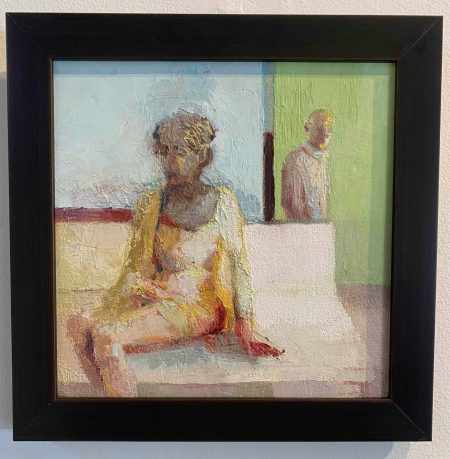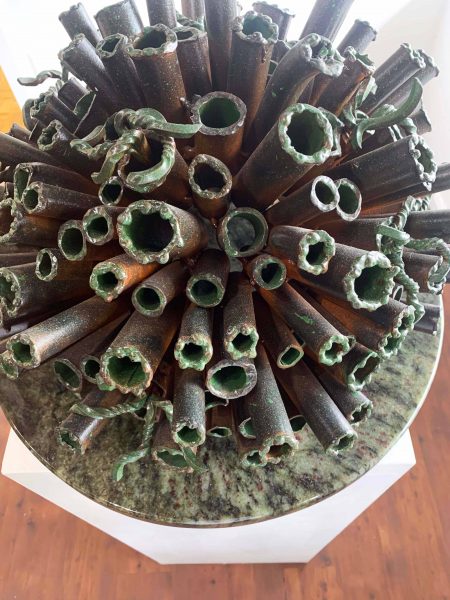The enchantment begins with the title of the two-person show at the Indian Hill Gallery: “The Sound of Still.” (The curator and exhibition coordinator, Casey Dressell, wisely stayed away from Simon and Garfunkel’s The Sound of Silence.) The exhibition “contemplates the idea of the sound of stillness–moments, figures, and forms at a standstill,” according to Dressell. She asks viewers to “… imagine what the forms and environments would sound like.” To me, “stillness” is not the same as “still.” More than the absence of sound or movement, “still” is a state of being.

Tina Tammaro, I wait without wonder, 2007-2021, oil on panel, 10” x 10”
The show pairs the painter Tina Tammaro’s “Intimate Series” with its areas of freely brushed thinned oil paint and of impasto with

Leslie Daly, Osage Oranges, 2019 and 2020, clay, acrylic paint, and gold leaf with aluminum posts for wall mounting, dimensions variable
Leslie Daly’s sculptures of welded steel, clay, and sculpture compound inspired by nature and the sea.

Tina Tammaro, the way she told him things that sounded true, 2011-2021, oil on panels, 12” x 12”
Perhaps influenced by friends who are actors or directors, Tammaro notes, “The development of each painting is a bit like writing a vital moment in a scene of a play.” Her compositions “come from an observed moment preserved in a photo or drawing, but with time, transform(ed) into something larger than the moment.”

Tina Tammaro, it was 65 degrees and not much left of the world, oil on canvas, 24” x 36”
For her titles, Tammaro lifts lines from the poetry of Char1les Bukowski. She found his book The Days Run Away Like Wild Horses Over the Hills on a Central Park bench “decades ago.” She spent the day drawing, and, by the time she was ready to leave, no one had claimed the book, so the painter took it. Tammaro found that his “poems offered me a clue to open my own life as a source for my work and as a reminder that the male perspective is often different from the female.” She continues, “To never forget that each individual sees the world in their own way. And most importantly, how to move past the personal to a more universal reading of the moment.”

Tina Tammaro, with the sun dreaming old battles, 2011, oil on linen, 48” x 72”
This is perfectly illustrated in with the sun dreaming old battles. A man and a woman stand in a kitchen that would never be in Architectural Digest. Facing the viewer, the man in the foreground has closed his eyes, tuning out the world. The kitchen’s appliances make a backdrop for the woman wearing a light-colored apron. She has turned her head to appraise him warily.
There is plenty to work with, to spin your own narrative, but Tammaro shares her own interpretation:
Here the architecture of the room and the placement of the figures declares them in trouble… (you are) witnessing a moment of discomfort between a brother and sister. They are both displeased but intensely tied to each other. The male’s face becomes a mask. He closes off in every way. She has said something uncomfortable but then thinks twice. Her posture, bathed in light, is beginning to change and retreat from the comment. This is the kitchen we grew up in. Loaded with the memories and tensions of family.

Tina Tammaro, sing sing through the darkened dream (triptych), 2010, oil on canvas, 48″ x 144″
All of Tammaro’s paintings on view are figurative with one exception: sing sing through the darkened dream (triptych). It’s a panoramic woodland scene rendered in a palette of light greens and green-tinged yellows with an Impressionist’s attention to light. The loose brushwork brought me close to the canvas. In the lower right corner are lines that appear scratched through the paint but are actually machine stitched; there is the human touch.

Leslie Daly, Habitat, 2019, bronze, limestone, and steel, 10” x 10” x 20 ½”
With the cast-bronze Habitat, Daly offers another idea of home. On her cousin’s farm in Pennsylvania, she found an abandoned paper wasp or hornet’s nest (vespiary) and took it back to her studio to make the mold for her lost-wax casting. The vespiary is used for only one season when the workers die and the queen lays her eggs elsewhere at the end of summer. The empty nest represents that moment in time when there is no sound, no buzzing, no noise of any kind. All is still.

Leslie Daly, Gastropoda & Coral Reef Series, 2021, sculpture compound, each 6” x 6”
“My work is an amalgam of things we know and imagine,” explains Daly. “It is not figurative, realistic, or classical… It is abstract, intuitive, and organic.”

Leslie Daly, Brown Sea Tube, 2018, steel and green marble base, 19” x 13” x 21” diameter base
The sculptor’s primary material is steel, a medium not conducive to “creating (the) organic, expressive art” that she aspires to. Yet “through heat and strong manipulation, steel can be a forgiving, communicative material,” Daly asserts.
Brown Sea Tube is a bouquet of steel tubes. They reminded me of flutes, leaving me to wonder what they might sound like beneath the sea or on the shore or if they’re capable of sound at all. With her torch Daly has hit the openings with her torch so they look like melted wax. Menacing wormlike twists emerge from the tubes.

Leslie Daly, Barnacles, 2019 and 2020, clay and sculpture compound, dimensions vary
As skilled as Daly is with steel, she also has a way with the more malleable clay and sculpture compound. She has fashioned barnacle forms that are larger than life; where they range from 0.4” to 2.7”. The artist installed an array them on a wall at the Indian Hill Gallery. However, they are independent pieces and can stand alone.

Leslie Daly, Coral Reef 4, 2021, sculpture compound and pulled glass, 5” x 5”
Daly makes a misstep when she places long, yarn-like strands of deep-green glass over her organic clusters of coral. At Brazee Street Studios, which is a complete glassworking facility, she learned glass can be pulled like taffy from a gob (yes, that’s the term) of glass. Before the not-quite-molten glass cools, it can be stretched, twisted, looped, bent. What Daly has done is what any beginning glass student does. It lacks the finesse she brings to her other mediums. Supple glass can be manipulated into delicate forms, like ballerinas, unicorns, and sailing ships. I’ll allow that the sculptor made what she wanted, not that she was not skilled enough to create what’s regularly seen on carnival midways. But it raises the question of why when she’s so accomplished with her other materials, she hasn’t been invested enough to master glass?

Leslie Daly, Akimbo, 2019, steel and sculpting compound, 64” x 47” x 18”
I think most of us are ready for a little outing for the pure pleasure of it. I recommend a drive to Indian Hill and a little quiet time at “Sound of Still.”
–Karen S. Chambers
“The Sound of Still: Tina Tammaro & Leslie Daly,” Indian Hill Gallery, 9475 Loveland Madeira Rd., Cincinnati, OH 45242. 513-984-6024, info@indianhillgallery.com. Tues.-Fri. 10-6 pm, Sat. 10-4 pm.



